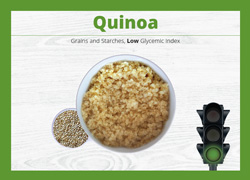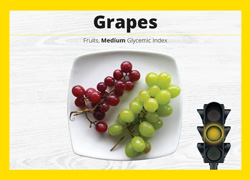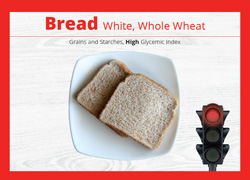What is the Glycemic Index?
The glycemic index (GI) is a scale that ranks a carbohydrate-containing food or drink by how much it raises blood glucose after it is eaten or drank. Foods with a high GI increase blood glucose higher and faster than foods with a low GI.
There are three GI categories:
- Low GI (≤ 55 GI units)
- Medium GI (56 to 69 GI units)
- High GI (≥ 70 GI units)
In figure 1 these three categories are represented using a traffic light.
 |
 |
 |
| Low GI = Green = Go = Choose most often | Medium GI = Yellow = Caution = Choose less often | High GI = Red = Stop = Choose least often |
Diabetes Canada recommends that Canadians living with diabetes choose lower GI foods and drinks most often to help control blood sugar.
Diabetes Canada’s most recent education materials have been designed to support healthcare providers and people affected by diabetes as they learn about GI together.
Here are some meal planning ideas to lower the overall GI of a meal:
- Cook pasta ‘al dente’ (firm). Check pasta package instructions for cooking time.
- Make fruits and milk part of your meal plate. These foods often have a low GI and make a healthy dessert.
- Try lower GI grains, such as barley and bulgur.
- Pulses (e.g. dried beans, peas, lentils and chickpeas) can be “grains and starches” or “meat and alternatives”. Swap half of your higher GI starch food serving with beans, lentils or chickpeas. For example, instead of having 1 cup of cooked short grain rice, have 1⁄2 cup of cooked rice mixed with 1⁄2 cup of black beans.
- Cool red or white potatoes after boiling or baking and enjoy them cold, such as in a potato salad.
- Use the Glycemic Index Food Guide [insert hyperlink] to swap high GI foods for low or medium (lower) GI foods.
Work with your patient to add to this list of suggestions based on their individual behaviour, goals and needs.
Some carbohydrate-containing foods and drinks have so little carbohydrate that they do not have a GI value. This does not mean they cannot be included as part of a healthy diet. Examples include: Green vegetables, lemons and some low-carbohydrate drinks. Diabetes Canada calls these foods and drinks “free” because they do not impact the blood sugar of people living with diabetes. You can put free foods in the green category, but they do not have a GI and have not been included in the food lists.
Glycemic index (GI) is one component of diabetes medical nutrition therapy and should be layered onto general dietary recommendations such as The Plate Method and Diabetes Canada’s Just The Basics. Using this holistic approach to GI education overcomes the potential misconception that a low GI diet supports overeating or choosing unhealthy foods.
Glycemic Index Education Materials for Professionals
Diabetes Canada Glycemic Index Food Guide
Diabetes Canada’s Glycemic Index Food Guide provides Canadians with an up-to-date and expanded food list. The food list organizes foods by GI category using the traffic light approach (green, yellow, red) and the following food groupings: Grains and Starches, Fruits, Milk and Alternatives and Meat and Alternatives.
Download and print a PDF version of the guide here, or order hardcopies of the guide here.
Diabetes Canada’s Glycemic Index Food Cards



Diabetes Canada’s Glycemic Index Food Cards have been developed to complement the Glycemic Index Food Guide. They are especially helpful when working with people who are visual learners or who have literacy barriers. Each card has a picture of a food from the food guide accompanied by its respective glycemic index- relevant traffic light colour and The Plate Method image with the appropriate part of the plate shaded in.
Order Glycemic Index Food Cards here.
Other Suggested Resources
- The Dietitians of Canada’s Learning on Demand course: Glycemic Index Education: Translating Knowledge to Action
- The University of Sydney’s Glycemic Index Website
Category Tags: Diet & Nutrition, Just the Basics, Management;